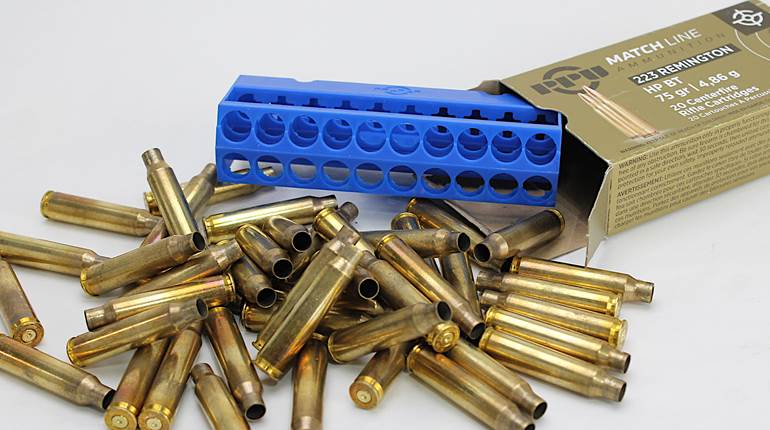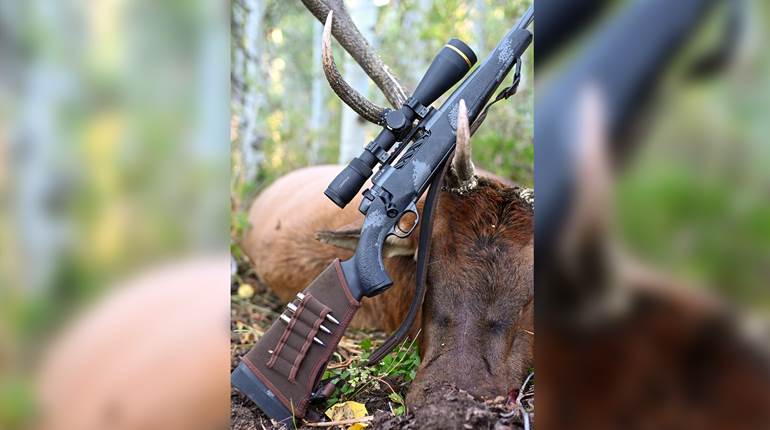
Here at American Rifleman we’re proud of our long track record covering firearms and the shooting world, but even the most authoritative source in the business can misfire on occasion. Such was the case back in July 1991 when a feature on the .470 Nitro Express by Field Editor Finn Aagaard carried the subhead, “Though little but nostalgia and the Cape buffalo may warrant its continued existence, this yesteryear big bore hangs on.”
While the titanic .470 will never be a market leader, at present more American companies than ever are loading it, and rifles are being chambered for it worldwide. Through the clarity of 20/20 hindsight we can see how our dismissive banner missed the mark, and how it also missed the handwriting on the wall.
Twenty-five years ago Americans who dreamed of blazing African game trails had a major hurdle to overcome even before leaving home. Unless their rifles were chambered for .375 H&H Mag. or .458 Win. Mag., obtaining factory ammunition could be difficult, and, regardless of caliber, bullet choices were limited. Few dealers stocked big-bore cartridges, and hunters eager to shoot a double gun or magazine rifle bearing a legendary name such as Rigby or Westley Richards had to find custom loads or try clearing an international shipment from a European maker.
That changed in 1989 when Federal Cartridge targeted a small but growing market with Premium Safari, an extension of the company’s breakthrough Premium brand that combined stringent quality control with custom bullets—for a price. But cost didn’t stop big-game hunters from embracing ammunition that rivaled top-rate handloads, and soon a new generation was realizing the advantage of controlled-expansion bullets.
Initially, Premium Safari offered four big-bore chamberings in nine different loadings, so that along with .375 H&H Mag. and .458 Win. Mag., stalwart British rounds such as .416 Rigby and .470 Nitro Express were introduced in American gun stores. In short order, custom bullets such as the Nosler Partition, Woodleigh Weldcore, and Trophy Bonded Bear Claw (soft-point) and Sledgehammer (solid) were available in both plains-game and dangerous-game loadings. Despite spotty attention from the sporting press, safari hunters took notice.
Encouraged by that interest, Federal took another decisive step, announcing at the 1992 SHOT Show that it had reached an agreement with Trophy Bonded owner Jack Carter to manufacture Bear Claw bullets for loading in its Premium ammunition. Carter had been working on the development of the Bear Claw for a decade, and eventually settled on a design that utilized solid copper rod as the jacket material. The bullet’s shank remained solid copper, while the nose was machined with tapered walls that encapsulated a lead core. With the core inserted, extreme heat was used to bond it to the jacket. Through a progressive hardening process that allowed the softer nose section to open dramatically, even while the core remained intact, Carter was able to obtain consistent, controlled expansion. The nose opened significantly, but not too fast and too much to hinder penetration.
The result was an ability to smash through thick hides and heavy bones and reliably penetrate the vitals of the world’s biggest game animals. To test and promote his new bullets, Carter staged a safari to Tanzania and Botswana. His party, including Aagaard, killed six Cape buffalo with the improved design, and in the July 1993 American Rifleman, Aagaard, a former professional hunter from Kenya, reported, “Their performance was well-nigh perfect. … Up till then I had preferred to use solids on buffalo, as I twice had soft-points break up with similar placement and fail to reach the vitals.”
As Federal began producing the Trophy Bonded bullets at its Anoka, Minn., factory in mid-1992, it continued to work with Carter on their development. Where Carter had relied on 100-percent-pure copper jackets, Federal switched to gilding metal, a 95/5 copper-zinc alloy, which was more compatible with its high-speed screw machinery. Federal’s production retained the solid-shank concept with a small radius of the lead core exposed at the nose, but it sharpened that ogive in many calibers in order to increase their ballistic coefficients. Initial runs focused on high-demand smaller chamberings such as .270 Win., 7 mm Rem. Mag. and popular .30-cal. cartridges, and once production lines had perfected the process, work began on the bigger Safari rounds. Commercially loaded Trophy Bonded Bear Claw (TBBC) ammunition made its debut in the 1993 Federal catalog.
Though Federal was taking a lead role in serving big-bore shooters, it was not operating in a vacuum. The introduction of the .416 Rigby was accomplished in tandem with Ruger, which added the iconic chambering in its No. 1-H Tropical single-shot and M77 Magnum bolt-action. For 40 years, Americans had been catching the safari bug by reading Robert Ruark’s seminal “Horn of the Hunter,” and now they could follow the lead of Ruark’s hero, professional hunter Harry Selby, and realistically own a .416 Rigby. European gunmakers were also keen to tap this burgeoning interest, and by the mid- to late-1990s, Holland & Holland, Kreighoff, Merkel, Heym, Blaser and CZ were importing double rifles and bolt-actions, including dangerous-game models. The prospect of owning a Nitro Express double was now more than just a pipe dream, though still rather pricey.
Competing U.S. firms had also stuck their toes in the stream, as both Remington and Weatherby introduced proprietary .416 magnum cartridges and corresponding rifles in 1988. Because the ammunition was readily accessible and relatively inexpensive, the .416 Rem. Mag. gained a firm foothold, and before long both of America’s favorite hunting rifles, the Remington Model 700 and Winchester Model 70, were available in the new chambering.
Federal continued its flexible strategy in developing what came to be known as Premium Safari Cape-Shok. New caliber offerings included the .416 Rem. Mag. (1997), .458 Lott (2006) and .500 Nitro Express (2008). And though it had a vested interest in pushing Trophy Bonded products, the company aggressively added the popular Barnes Triple-Shock X-Bullet (TSX) in 2006 and Swift A-Frame in 2010.
Although its safari ammunition business was never high-volume, dominating an arena where failure could have deadly consequences certainly helped to enhance Federal Premium’s credibility and brand recognition. However, in the mid-2000s, a few troubling reports from Africa about TBBC bullet failures mobilized the company to review, and ultimately to improve, its product. As is often the case when a particular product goes through “generational” changes, fans of the original version tend to think it can’t be topped, and certainly that was the case with the Bear Claw. Jack Carter’s brainchild had been so advanced for its time that some satisfied users were convinced the earlier solid-copper jacket material and forming methods made it better than the Federal Cartridge output, despite the fact that Carter had worked with Federal on those changes.
Upon investigating, Federal found the “overall perception from the vast majority of users continues to be very positive,” but nonetheless identified three potential areas of improvement. 1.) The upset needed to be more consistent. On occasion, petals were separating and expansion was non-symmetrical. 2.) Accuracy was “gun sensitive,” especially in lighter calibers. 3.) Loaded-cartridge visuals needed upgrading. Flux stains around the bullet tip and dings on the exposed lead nose compromised consumer confidence in an expensive product.
Product Development Manager Larry Head and his engineering team studied the issues and, aside from retaining the bullet’s basic structure, decided on a fundamental makeover. Jackets would be formed from gilding-metal wire rather than rod stock because they determined the wire contained fewer impurities, and that translated to less variation in jacket geometry. The old screw-machine forming method was replaced with an impact-extrusion process utilizing high pressure to convert the raw wire into shaped jackets. The engineers were convinced these measures would standardize expansion characteristics, prevent the loss of nose petals, and yield better concentricity for improved accuracy.
Accuracy was also addressed by adding a series of circumferential grooves around the bullet shank, a la the Barnes TSX. This longtime cast-bullet feature had cured a nagging tendency for Barnes’ hard copper bullets to be inaccurate in some rifles and leave excessive barrel fouling. The innovative TSX routinely delivered tight groups from just about any gun, and Federal followed suit, applying the groove technology to its related Trophy Bonded Tip bullet, also to great effect.
According to Federal, the grooving creates more surface area and reduces bullet stiffness, which in turn reduces barrel vibration. As a result, bullets recover quicker from yaw, that is, from a natural tendency to oscillate from a straight flight path as they exit the muzzle. As a final measure Federal decided to nickel-plate the bullets, which meant that the entire cartridge would wear a thin nickel coating since the cases had been plated for more than a decade. Nickel-plating helps to prevent corrosion and because of its natural lubricity it aids smooth feeding and extraction. Accordingly, the engineers guessed that plating the bullets would reduce bore friction and barrel fouling, and thus enhance accuracy. Subsequent testing proved the point, especially as barrels “shot in” and passed the 300-round threshold. The sleek, high-tech look of an all-silver round was not lost to Federal’s marketers, who coupled that with new see-through, hard-shell packaging to give the product shelf-appeal befitting its premium quality.
Quality control of the entire Premium brand is extensive. “We have a disciplined internal culture that runs through the manufacturing and assembly processes from case to primer to propellant to bullet,” said ATK Federal Director of Technology Drew Goodlin. “With Cape-Shok, quality is verified by constant testing, pulling samples off the line for checks with chronographs and pressure gauges. All of these loads have 100 percent mechanical powder detects to make sure the correct powder weight is in each shell.” And to ensure spot-on functioning in wide-ranging weather conditions (think 100 degree F-plus in Africa to blizzards in Alaska), Safari loads use specially selected propellants that provide consistent pressures and velocities over a wide temperature range and are finished with mouth varnish and primer lacquer for waterproofing.
Presently the line offers 10 big-bore calibers ranging from the new .370 Sako Mag. up to .500 Nitro Express, and it boasts the largest selection ever of the world’s toughest bullets. That’s a nod to just how knowledgeable today’s riflemen are in regard to bullet performance and the pro’s and con’s of our leading bullet options. “All along, our goal has been to provide the best of the best, and we now offer the calibers and bullets that the vast majority of safari hunters want in a premium product,” said Head.
Clearly we were wrong two decades ago in all but sounding the death knell of the .470 Nitro, but let’s not be too harsh in judging the past. The editors back then (me included), had been conned by a pervasive, but false, media campaign that hunting Africa’s greatest beasts was about to end. What we failed to see was the power of the marketplace and determined sportsmen to conserve this vital natural resource.






































